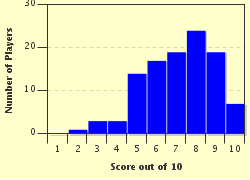Quiz Answer Key and Fun Facts
1. Which of the following things could be described as a small rock floating around our galaxy?
2. There is a real type of space rock known as an 'Earth grazing fireball'.
3. When it comes to the world of space rocks, what exactly is a 'fall'?
4. What is the primary difference between a moon and an asteroid?
5. Why does our planet have so few meteor impact craters?
6. What is it called when many meteors occur in a close time frame in the same part of the sky?
7. What is the name for the main body of a comet?
8. Where is the impact crater that caused the dinosaurs to become extinct?
9. What are Vesta, Pallas, Ceres, and Hygiea?
10. Which of the following options is a substance, sometimes used in jewelry making, that is believed to be formed by a meteor impact?
Source: Author
dcpddc478
This quiz was reviewed by FunTrivia editor
rossian before going online.
Any errors found in FunTrivia content are routinely corrected through our feedback system.

